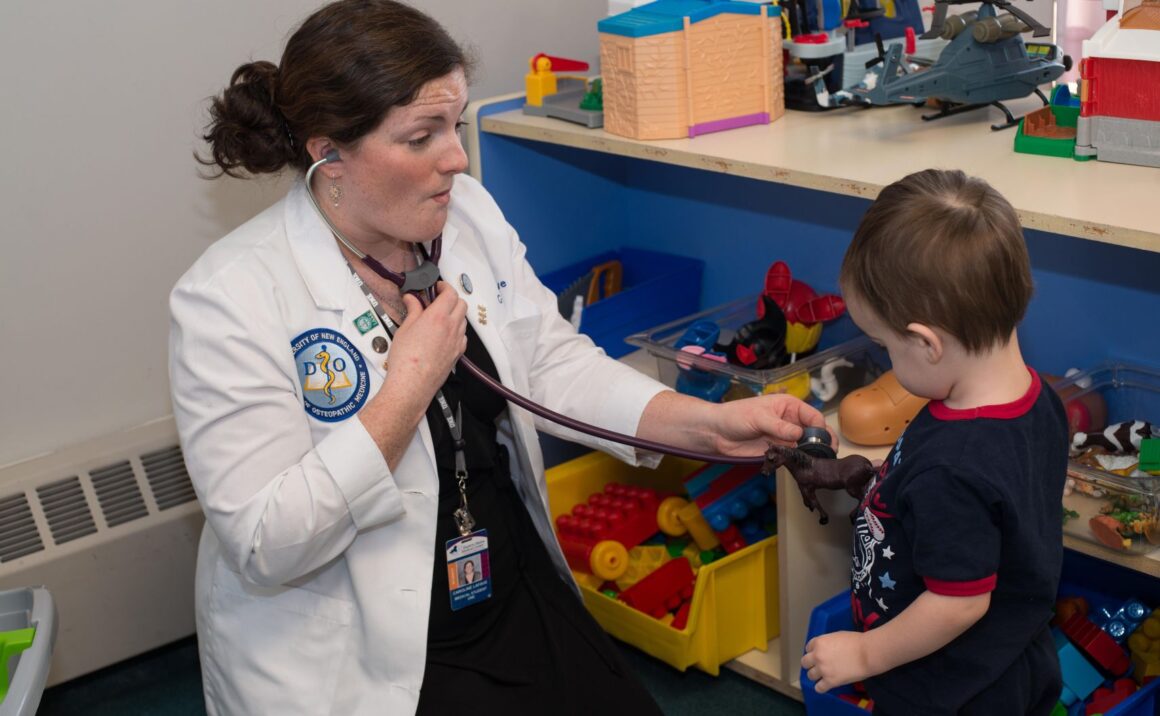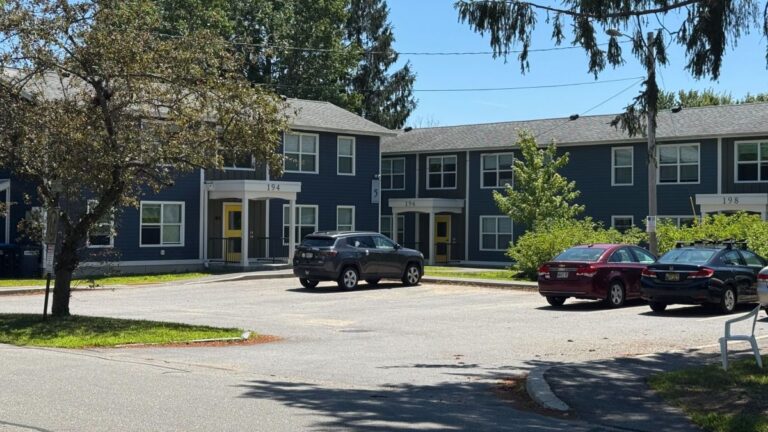In the United States and across the world, birth rates are falling.
Fertility rates in the United States reached a historic low in 2023, and have dropped more than twenty percent in the past three decades, to 1.6 births per woman of reproductive age. In Maine, where fertility rates have long been lower than the national average, that figure was 1.47 births per woman in 2022.
The reasons are complex, driven in part by dramatic reductions in teen pregnancies and fewer unplanned pregnancies. But the change — coupled with a nationwide shortage of physicians, low reimbursement rates for care and people entering pregnancy with more complex medical needs — is the primary force behind a cascade of birthing unit closures in Maine and across the nation.
Fewer babies being born means it is difficult for providers to maintain their skills and harder to sustain services financially; once a unit closes, it becomes more difficult to attract young families to an area, pushing fertility rates into a downward spiral.
As birthing units shutter and some rural hospitals close their doors entirely, providers around the state are looking to make it easier to train physicians in rural areas, cross-train staff who are already in rural hospitals in obstetrics and make better use of highly-trained nursing staff and other providers to lessen the burden on physicians and prop up the birthing units that remain.
The state already has a range of services in place designed to support families, including services for parents struggling with substance use disorder, telehealth programs for patients to access mental health care and remote blood pressure monitoring, which allows patients in rural areas to avoid frequent office visits.
“The state is taking this seriously,” Anne Marie van Hengel, a retired obstetrician from Portland, told The Maine Monitor in early March. “No one is looking at this and saying, ‘oh, no big deal.’ These birthing unit closures, they are really an issue.”
Leveraging existing providers
One of the most approachable solutions to the rural health care crisis, said several experts, and one that can be implemented immediately, is making better use of providers who are already part of the community.
That’s what hospital administrators did in Washington County. Two years ago, faced with a nearly $1.5 million gap between projected costs and nursing staffing charges, a declining number of births and the very real prospect of closing the sole remaining maternity unit in the county, hospital administrators at Down East Community Hospital in Machias decided to cross-train nurses from the medical/surgical department in obstetrics.
Med/surg nurses were trained in resuscitating newborns. Staffing shifted slightly to have just a single dedicated obstetric nurse on shift rather than two, allowing the hospital to reduce its reliance on costly traveling providers. A labor-trained medical-surgical nurse fills in the staffing gaps, and a multi-disciplinary team, including emergency department staff, anesthesiologists, a pediatrician, a nursing supervisor and a respiratory therapist, are on call.
The transition was not seamless. Some nurses, uncomfortable working with highly specialized obstetrics cases, reportedly left the hospital, according to nursing union representative Roberta Alley, who told The Monitor last year that the decision to cross-train nurses was “highly unusual.”
In an email this February, DECH spokesperson Julie Hixon said the flex arrangement was still in place and “has helped considerably with closing the gap. Even though our births were down in 2023, we feel good about the future of our OB program because we believe our flex approach will only improve over time.”
Surgeons trained to perform C-sections can also provide care in places where a dedicated obstetrician is not available.
That was once the case at Mount Desert Island Hospital in Bar Harbor, where Linda Robinson, a certified nurse midwife, worked for decades.
“Midwives used to provide all of these services. It was never an issue,” said Robinson, who recently taught a class on the history of midwifery in the U.S. at the College of the Atlantic. “The one thing [hospitals] absolutely need an OB/GYN for is a C-section, which can be done by a general surgeon.”
With low birth rates making it financially unsustainable to retain obstetricians in certain areas and challenging to keep them trained, Robinson advocates for hospitals training surgeons to perform complex births while nurse-midwives assist or, in some cases, take the lead during deliveries.
“There’s a younger generation of doctors coming forward [and] many of them have been trained by midwives, so they appreciate our skill,” said Robinson.
Allowing specially-trained nurses to take first call, bringing in a physician only if a case becomes complex or requires a C-section, can also help alleviate the burden of being constantly on call, said several providers. Sharing personnel across hospitals within a system can also reduce the strain.
Cross-training family medicine physicians, who outnumber obstetricians more than ten to one, has also been proposed as a way to boost obstetric care in Maine.
According to a 2024 paper published by the Maine Rural Graduate Medical Education Collaborative, Maine graduates about four obstetric residents annually, all out of Maine Medical Center in Portland. By contrast, the state graduates around 35 family medicine residents each year out of programs in Portland, Lewiston, Augusta and Bangor.
The authors suggested that Maine explore establishing a family medicine obstetrics fellowship to train family medicine physicians in obstetrics. Twenty-eight states offer such fellowships, including Massachusetts.
“In Maine, where Family Medicine physicians are more widespread through the State, it would be beneficial to cross-train rather than rely on recruitment,” the authors wrote.
Cross-training providers who are already part of the community is often much easier than hiring those who have few or no connections to a place.
“No question about it, recruitment is extremely challenging,” said Mike Towey, a speech pathologist who recently retired from Waldo Hospital. “It’s all about… developing a sense of community to attract and recruit people.”
Rural hospitals in Maine face significant challenges with recruitment due to scheduling, fluctuating patient numbers and internal hospital dynamics, according to a 2024 Roux Institute report.
But, according to the same report, rural hospitals in Maine see “high retention of employees from the community,” and solid partnerships and communications with other providers, such as EMTs, community midwives, and other types of community-based care and services.
“When they’re trying to recruit medical professionals for these rural areas, nobody wants to move there, nobody wants to put their kids in the schools, and they don’t make enough money,” said Robinson. “These people are already part of the community.”
Incorporating midwives, doulas, training EMS
Hospitals in Maine are also incorporating more nurse-midwives — registered nurses with a master’s degree in nurse-midwifery — into their practices.
Maine’s largest hospital systems, MaineHealth and Northern Light Health, offer midwifery services at several hospitals. Nurse-midwives are licensed to attend births in hospital settings as well as at birth centers and at home, although the vast majority practicing in Maine are affiliated with larger providers.
A nationwide blueprint published by the Biden Administration for addressing the maternal health crisis calls in part for expanding access to licensed midwives, doulas, and freestanding birth centers and encouraging insurance companies to improve reimbursement for and coverage of nurse-midwives and perinatal supports, such as doulas and nurse home visits.
Other countries rely far more heavily on midwives than the United States — in most countries, midwives far outnumber obstetricians. In some cases, research has suggested that midwifery-led care models provide care that is comparable or better than obstetrician-led care, according to the CommonWealth Fund.
“Outside the U.S., midwives are often considered the backbone of the reproductive health system,” wrote the authors.
But midwifery training in many of those countries is far more standardized than it is in the United States. It is also often far more integrated into the health care system, with greater coordination and support for midwifery-led care teams, said several midwives.
“Midwives are the answer to maternity care in America. But just putting that burden onto us without giving us the infrastructure to do it is not sustainable and does not actually create a better care structure,” said Ariel Bernstein, a certified professional midwife who recently graduated from Harvard with a master’s in public health.
According to the National Academy for State Health Policy, 18 states and Washington, D.C., reimburse non-nurse midwives (whose titles and certification vary) under Medicaid; nurse-midwives are covered under Medicaid in all jurisdictions. MaineCare, Maine’s version of Medicaid, covers nurse-midwives but does not reimburse for services by midwives without a nursing degree.
Hospital administrators and state officials interviewed by The Maine Monitor said they had no plans to incorporate independent midwives (those who are not trained as nurses but instead licensed as certified professional midwives) into their practices, in part for liability reasons.
Some in Maine are pushing for increased access to doulas, non-clinical providers who provide educational, physical and emotional support to families and people who are pregnant and postpartum. A bill sponsored by Sen. Denise Tepler (D-Dresden), would require MaineCare to cover doula services.
The bill, however, faces an uphill battle, as lawmakers in Augusta fight over a supplemental budget and a budget shortfall for MaineCare, the state’s insurance program for low-income residents. MaineCare covers roughly 37 percent of all births in Maine.
A recent grant awarded to the Maine Department of Health and Human Services, however, requires the state to cover doula services within the first three years, according to previous reporting by The Monitor.
A dozen states and Washington, D.C., have implemented Medicaid coverage for doula services, according to the National Health Law Program.
Rural emergency medical service providers are also increasing training for their staff, who are being called upon more frequently to handle out-of-hospital births and newborns.
“We’ve also seen a tremendous increase in the number of births that happen outside of the hospital, triple the numbers from prior to the COVID pandemic,” said Mark Minkler, program manager of EMS for Children, speaking to Maine Public in late February.
“If [a nearby hospital doesn’t] have the internal capacity to admit patients that are having complications, EMS is the workforce that moves those patients to other locations, and that can put a tremendous strain on both systems,” said Minkler, “and on the patients that have to be transported and their connection with their families and homes.”
Maine also has CradleME, a free program that began in 2017 in which public health nurses make home visits to anyone who is pregnant or postpartum, or anyone caring for an infant, to help with parenting, breastfeeding, nutrition and any other concerns.
Decades of research have shown that sending nurses into people’s homes is one of the most effective ways to reduce pregnancy complications, pre-term births, infant deaths, child abuse and injury, violent crimes and substance abuse.
“You do not have to have a problem,” said van Hengel, who likened the program to support offered in much of Europe, where “Someone comes by and says, ‘so, how’s it going? What’s up?’”
But CradleME has struggled for years to reach as many families as the state has hoped. Many patients and providers are unaware the program exists, or may offer information as families are leaving the hospital after giving birth, as parents are overwhelmed and exhausted.
The Monitor was unable to reach CradleME representatives before press time.
“For a lot of people, including myself as a provider, I did not really realize that that was something that was accessible for anyone,” said van Hengel. “The context really needs to be ingrained early, so that providers or women or families know about it ahead of time.”
Training future providers in rural areas
Residency programs, where physicians spend time training in various specialties after medical school, are mostly hosted in largely medical centers, where doctors-in-training have access to a host of specialist attending physicians and exposure to a variety of cases.
While that’s valuable, said Dr. Jane Carreiro, dean of the University of New England College of Osteopathic Medicine, Maine’s only medical school, it doesn’t reflect the environment that rural physicians end up practicing in, one with limited specialist access where complex cases will be transferred to larger facilities.
Starting a new residency program is nearly impossible for small hospitals, said Dr. Carreiro, because it requires not only funding but also access to highly specialized staff certified in a range of fields, including maternal-fetal medicine, urogynecology and reconstructive pelvic surgery, gynecologic oncology, and reproductive endocrinology and infertility.
Criteria for residency programs are set by the Accreditation Council for Graduate Medical Education, she said, “which is biased towards large academic medical centers.”
But most doctors in community hospitals won’t ever need or have access to that level of care once they’ve started their careers.
“It’s throwing the baby out with the bathwater,” said Dr. Carreiro of the requirements for starting new residency programs. “You want this high, high standard, but 90 percent of people don’t need that. And so you eliminate the opportunity for those 90 percent of people to have any care because you’ve created so many obstacles.”
MaineHealth currently operates the state’s only obstetrics residency program, at Maine Medical Center in Portland.
While establishing dedicated obstetric residency programs in small rural hospitals may be a significant lift, hospitals are working together to expose more doctors-in-training to rural obstetric medicine, in the hope that they’ll stay in the area after graduation.
The Maine Rural Graduate Medical Education Collaborative recently received a three-year, $667,330 federal grant aimed at developing obstetrics education programs focused on rural community needs.
The program has been in place for several years in a range of other specialty areas, allowing budding physicians to train at partner hospitals around the state, and offering housing stipends to eligible residents. Of the ten residents who graduated in 2024, six chose to practice in rural settings, two of them in Maine, according to a paper published earlier this year in the Journal of Maine Medical Center.
“It creates an opportunity for students in rural residency rotations to learn important skills to support pregnant patients and their families,” said Dr. Kalli Varaklis, designated institutional official at MaineHealth, in a statement in January announcing the collaboration.
Financial reforms
Experts The Monitor spoke to said one of the most impactful ways to support rural birthing hospitals would be for MaineCare to pay more for their services. Thirty-seven percent of all births in the state are covered by MaineCare, and Maine recently expanded postpartum coverage to 12 months after the end of pregnancy, which research has shown is the deadliest time for new mothers.
On average, private insurance reimburses providers in Maine $23,595 for a C-section and $14,630 for a vaginal delivery, according to research by the Health Care Cost Institute. MaineCare, however, reimburses providers just a fraction of the cost of providing care — $4,607 for a vaginal birth and $6,847 for a C-section.
Significant reimbursement reforms are unlikely in the current budgeting environment, however. The program is facing a $118 million budget shortfall; the state began temporarily holding payments to some participating providers on March 12.
Maine is examining the payment model for maternity services under MaineCare as part of a $17 million, ten-year grant announced earlier this year, said Dr. Amy Belisle, chief child health officer for the Maine Department of Health and Human Services. A plan for the grant calls for the state to implement a new “value-based” payment model by 2028.
Under that model, payments would be tied in part to the implementation of evidence-based best practices that address issues like mental health, hypertension and sepsis in pregnant people.
“How do we make sure that we’re getting good outcomes? So we’re not just paying for care, but we’re paying for quality care,” said Dr. Belisle.
The $17 million grant also has funding to support birthing units at risk of closing, said Dr. Belisle, although those funds do not kick in for several years. The first three years of the grant are focused on planning; the remainder are for implementation.
Whether the grant will survive the cuts being made by the Trump Administration is hard to tell.
“We’re actively monitoring what the situation is and if things change then we’ll think through that at that time,” said DHHS spokesperson Lindsay Hammes. “But given that there’s not been an indication that that funding is going to be frozen, the work continues.”








